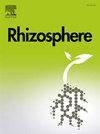Integrated management of root-knot nematodes on tree tomato
IF 3.4
3区 生物学
Q1 PLANT SCIENCES
引用次数: 0
Abstract
Tree tomato is an economically and nutritionally important horticultural crop in Kenya and globally. However, this crop is attacked by root-knot nematodes (RKNs) resulting into yield losses. The study's objective was to establish two-season experiments to determine the effectiveness of combining Colletotrichum nigrum or commercial Trichoderma asperellum with Lantana camara L. leaf extract and Velum® (active ingredient = fluopyram) against RKNs on tree tomatoes under greenhouse and field conditions. Tree tomato roots were collected for isolation of C. nigrum. Lantana leaves were collected, dried, ground into powder and water extract obtained from 200g w/v. Pots containing seedlings were treated with 2000 infective juveniles of RKN in the greenhouse. The treatments were applied at transplanting. Field experiments were established on RKN-naturally infected plots. Greenhouse and field treatments were arranged in completely randomized and randomized complete block designs, respectively, with four replications. To asses RKN suppression, nematodes were extracted from 200 cm3 of composite rhizosphere soils or 5g of roots per treatment using modified Baermann extraction tray method and counted under the microscope. Plant height was measured in centimeters from the soil line to the newest apical shoot and compared. Shoots were separated from roots at the base, labelled, oven-dried and weight recorded in grams while nematode reproduction factor was calculated as a ration of final to initial nematode populations. Galling and egg mass indices on roots were scored on a scale of 0–5. Data was analyzed using ANOVA, SAS software version 9.2, and significant means were separated using Tukey's Honest Significant Difference at 5% (P ≤ 0.05). The treatments were significantly (P ≤ 0.05) consistent in reducting plant disease and increasing growth parameters under greenhouse and field tests. Colletotrichum nigrum + Lantana extract + Velum® significantly reduced root nematodes (>21%), gall and egg mass indices (<2.0 and < 1.5, respectively) compared to control (5.0) and reproduction (<1%.) The same treatment increased shoot height (>80%), dry root weight (>50 %) and dry shoot weight (>70%). These findings provide an additional RKN management strategy that can be incorporated into a sustainable integrated nematode management to boost agricultural productivity.
求助全文
约1分钟内获得全文
求助全文
来源期刊

Rhizosphere
Agricultural and Biological Sciences-Agronomy and Crop Science
CiteScore
5.70
自引率
8.10%
发文量
155
审稿时长
29 days
期刊介绍:
Rhizosphere aims to advance the frontier of our understanding of plant-soil interactions. Rhizosphere is a multidisciplinary journal that publishes research on the interactions between plant roots, soil organisms, nutrients, and water. Except carbon fixation by photosynthesis, plants obtain all other elements primarily from soil through roots.
We are beginning to understand how communications at the rhizosphere, with soil organisms and other plant species, affect root exudates and nutrient uptake. This rapidly evolving subject utilizes molecular biology and genomic tools, food web or community structure manipulations, high performance liquid chromatography, isotopic analysis, diverse spectroscopic analytics, tomography and other microscopy, complex statistical and modeling tools.
 求助内容:
求助内容: 应助结果提醒方式:
应助结果提醒方式:


